Physical Address
304 North Cardinal St.
Dorchester Center, MA 02124
Physical Address
304 North Cardinal St.
Dorchester Center, MA 02124
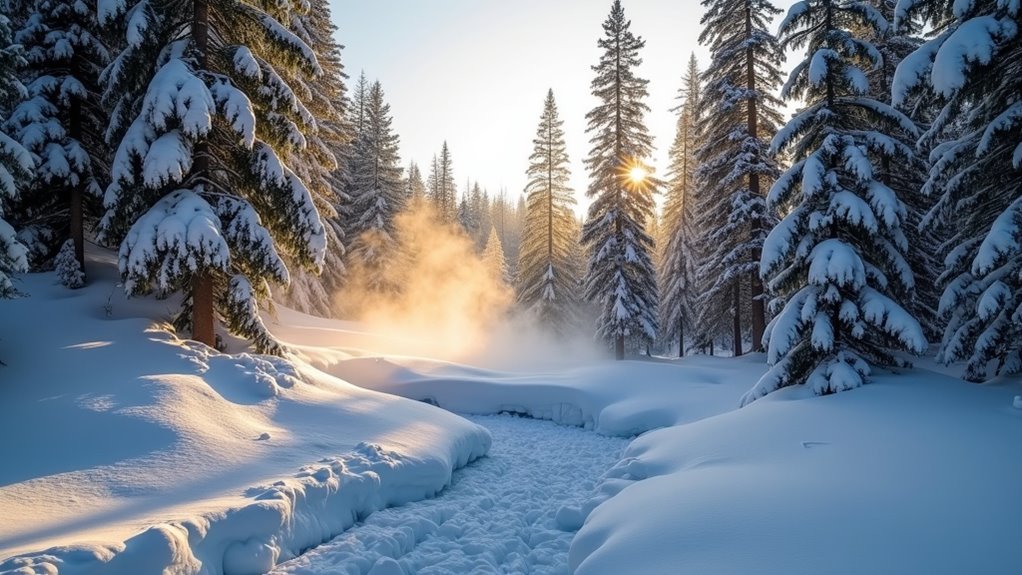
Outdoors winter camping demands critical campsite selection skills that separate survivors from statistics—discover the 9 essential factors before your next cold-weather adventure.
You’re about to set up camp in winter’s unforgiving embrace, where a single poor decision can turn your adventure into a survival situation. Unlike summer camping, winter demands you understand how wind, snow, and cold work together to either protect or threaten your safety. The campsite that looks perfect during daylight can become a death trap when temperatures plummet and storms roll in. Here’s what separates experienced winter campers from those who never venture out again.
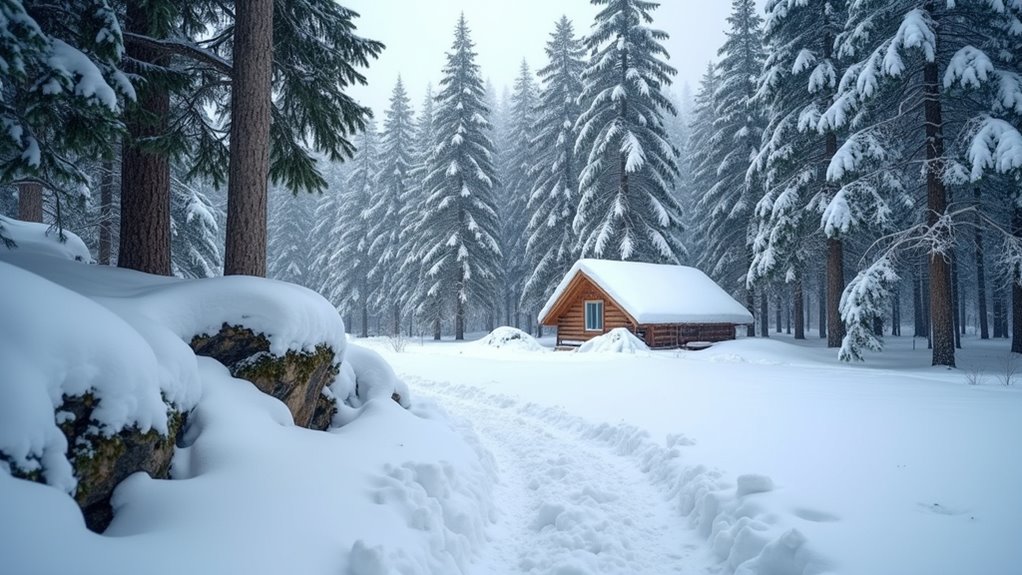
When winter winds cut through your campsite, they’ll sap your body heat faster than you can generate it, making wind protection your top priority in site selection. Look for natural windbreaks like dense tree lines, rock formations, or ridgelines that’ll shield you from prevailing winds.
Check wind direction by observing snow patterns—drifts and scoured areas reveal where wind hits hardest.
Avoid exposed ridgetops, open meadows, and valley bottoms where cold air settles. Instead, position yourself on the leeward side of hills or behind substantial barriers.
Trees provide excellent protection, but stay clear of dead branches that could snap under snow weight.
Test wind exposure by spending a few minutes at potential sites before committing. Your shelter’s effectiveness depends heavily on smart positioning within the landscape’s natural protection.
Just as church camp experiences create lasting bonds through shared challenges in nature, winter camping builds character and resilience when you face harsh conditions together with proper preparation.
Even if you’re not planning to ski or climb steep slopes, avalanche terrain can extend far beyond obvious danger zones, making risk assessment crucial for any winter camper in mountainous areas.
Avalanche danger zones extend far beyond steep slopes, making terrain assessment essential for all winter mountain camping.
Avalanches can travel considerable distances into valleys and flat terrain where you might consider camping.
Check local avalanche forecasts and bulletins before your trip.
Look for terrain traps like gullies, creek beds, or depressions where snow debris accumulates.
Avoid camping directly below steep slopes, cornices, or chutes.
Choose sites on ridges, benches, or areas with dense timber that indicate stable terrain.
If you’re unfamiliar with avalanche assessment, stick to well-established campgrounds or lower-elevation areas.
Consider taking an avalanche safety course to better understand snowpack dynamics and terrain evaluation techniques.
Understanding your camping style preferences will help you determine whether you’re prepared for the additional complexities and risks that winter mountain camping presents.
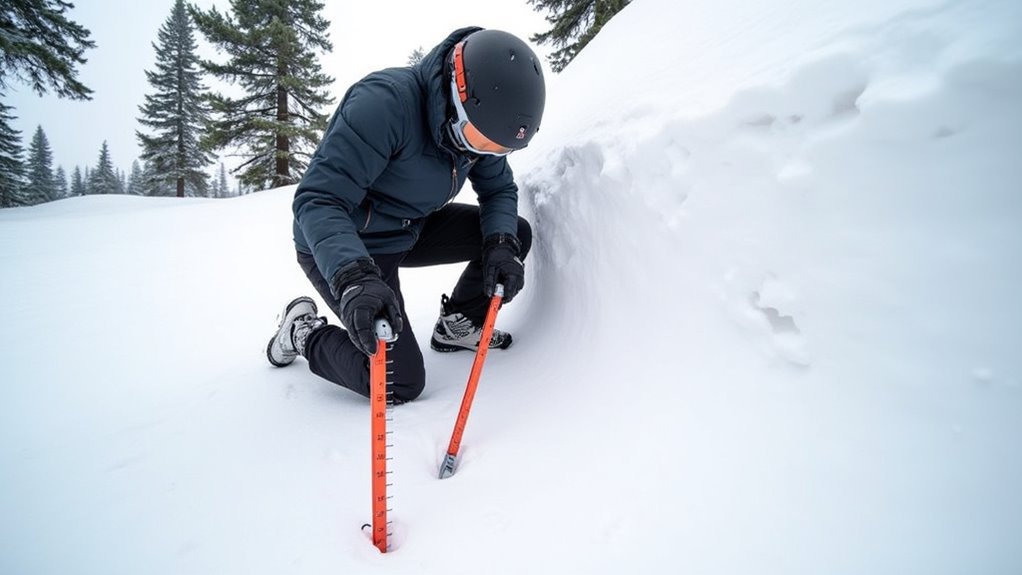
Snow depth directly affects your camping setup, gear choices, and overall safety in winter conditions. You’ll need to probe the snow using trekking poles or an avalanche probe to determine depth and consistency.
Look for areas where snow is at least three feet deep for insulation but stable enough to support your tent and gear.
Test the ground beneath by pushing your probe down to check for rocks, logs, or uneven terrain that could create uncomfortable sleeping conditions.
Avoid areas where wind has created hard, icy surfaces that’ll make staking your tent difficult.
Deep, powdery snow might seem appealing, but it can collapse under weight, creating dangerous air pockets around your shelter.
Choose consolidated snow that’s been naturally compressed by wind or previous weather patterns for the most reliable foundation.
For those planning extended winter stays, consider how caravan camping can provide additional shelter and warmth when positioned strategically alongside your main tent setup.
Since dehydration poses a serious threat in cold weather, you’ll need to identify water sources before setting up camp. Look for flowing streams or rivers that won’t freeze completely, as moving water stays liquid longer than stagnant pools. Avoid water sources that require dangerous access, like steep slopes or unstable ice.
If you can’t find liquid water, you’ll need to melt snow or ice. Choose clean, white snow over dirty or colored varieties, and remember that snow yields surprisingly little water—you’ll need large quantities. Ice produces more water per volume than snow.
Pack extra fuel for melting snow, as this process consumes significant energy.
Consider camping near a reliable water source to minimize trips and conserve energy for other essential tasks. Just as with boat rentals, accessing remote water sources requires careful planning to ensure you have the necessary equipment and backup options for your outdoor adventure.

While nighttime temperatures grab most of your attention during winter camping planning, daytime sun exposure can make the difference between a comfortable camp and a miserable one. You’ll want to position your campsite where it receives maximum sunlight during the day, especially morning sun that’ll help warm your tent and gear after a cold night.
Look for south-facing slopes or clearings that aren’t blocked by trees, ridges, or other terrain features. These spots warm up faster and stay warmer longer.
However, don’t sacrifice wind protection for sun exposure—you’ll need to balance both factors.
Consider how the sun’s path changes throughout the day. A spot that’s sunny at noon might be shaded by 3 PM, leaving you cold during those vital late-afternoon hours.
If you’re planning to combine winter camping with water access for activities like fishing or washing, look for campsites near unfrozen water sources where you can safely bring a boat along for added convenience and functionality.
Before you commit to any winter campsite, you’ll need to map out multiple routes for getting help or getting out fast. Winter weather can change dramatically, creating dangerous conditions that require immediate evacuation.
Scout at least two different paths back to your vehicle or main trail before setting up camp. Mark these routes with bright flagging tape or GPS waypoints so you can find them in whiteout conditions or darkness. Test your chosen escape routes while visibility is good and conditions are stable.
Consider how emergency responders would reach your location. Can rescue vehicles access the area? Is cell service available from higher ground nearby? Keep a whistle, mirror, and bright cloth accessible for signaling. Winter emergencies don’t wait for convenient timing.
Plus, ensure you have access to water sources for both drinking and basic hygiene needs, as camping showers may be necessary even in emergency winter conditions.
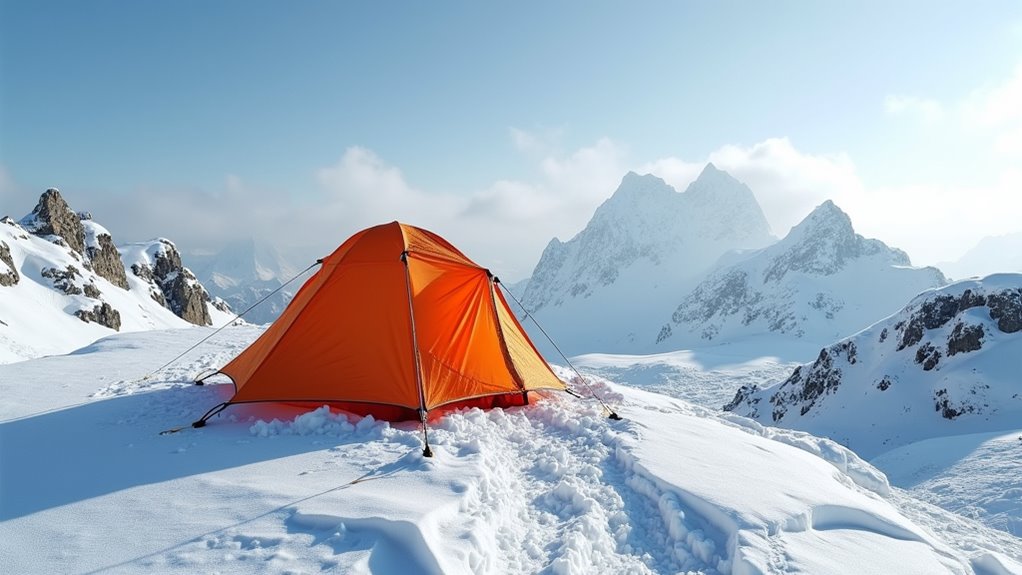
Setting up your tent on snow and ice requires completely different techniques than summer camping. You’ll need to pack down the snow with your boots or snowshoes to create a firm, level platform. Compact snow provides better insulation than loose powder, which can shift overnight and collapse under your tent’s weight.
Bring extra-long tent stakes or specialized snow anchors since regular stakes won’t hold in frozen ground. Snow flukes, deadman anchors, or even buried stuff sacks filled with snow work better than traditional stakes. Clear away any loose snow before pitching your tent to prevent melting and refreezing underneath.
Consider your tent’s footprint carefully – you’ll need more space for gear organization and snow management. Test your setup at home first, so you’re not fumbling with unfamiliar techniques in harsh conditions.
If camping in areas where hunting may occur, wear bright colors and make yourself visible to hunters while camping to ensure your safety.
Since winter conditions drastically limit your firewood options, you’ll need to scout dead-standing trees and fallen branches that aren’t buried under snow. Look for dry wood above the snowline – it’ll burn better than wet, frozen alternatives.
Choose your campsite with fire safety in mind. Avoid areas beneath snow-laden branches that could drop onto your fire. Clear snow down to bare ground in a wide circle around your fire pit, as melting snow can extinguish flames and create muddy conditions.
Keep your fire contained with rocks or a designated fire ring. Wind patterns change in winter, so position your fire considering prevailing winds and your tent’s location.
Always have water or snow nearby for emergencies, and completely extinguish fires before sleeping. Once your fire is safely established, it can serve as the centerpiece for various fun activities like storytelling, cooking hearty meals, or warming up after winter hiking adventures.
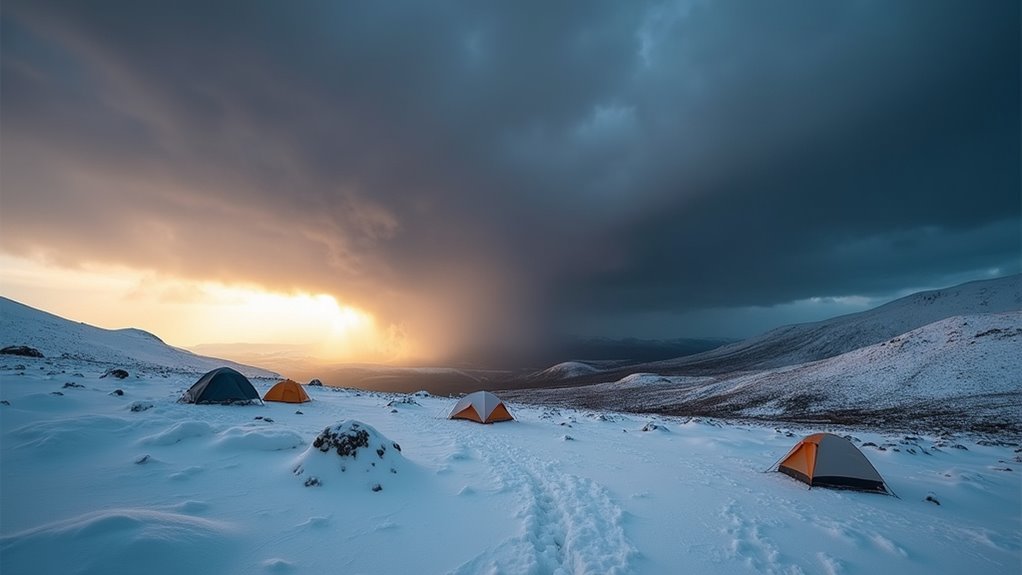
While summer weather can shift quickly, winter storms pack far more dangerous potential and demand your constant attention. You’ll need to track approaching systems at least 48-72 hours before your trip using reliable weather apps and NOAA forecasts.
Pay special attention to temperature drops, wind speeds, and precipitation types—rain turning to snow creates hazardous conditions.
Learn your area’s typical storm paths. Coastal regions often see nor’easters, while mountain areas face orographic lift patterns that intensify snowfall.
Wind direction matters too; storms approaching from certain angles can create dangerous downdrafts or snow loading.
Don’t just check the forecast once. Weather changes rapidly in winter, so monitor conditions hourly once you’re camping.
Have multiple communication methods ready, and always plan escape routes if conditions deteriorate unexpectedly. Once you’ve established your safe campsite and weather monitoring routine, consider planning some family camping activities that work well in winter conditions to keep everyone engaged and warm.
You’ll find that mastering these nine winter campsite factors isn’t just about survival—it’s about transforming harsh conditions into your advantage. Coincidentally, the same ridge that blocks brutal winds often provides the best sunrise views for warming your camp. The avalanche-safe zone you’ve chosen frequently sits near flowing water sources. When you’ve planned your escape routes and secured your gear properly, you’ll discover that winter’s challenges become manageable adventures you’ll actually want to repeat.